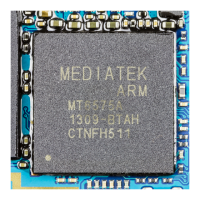Introduction
ARM DDI 0388I Copyright © 2008-2012 ARM. All rights reserved. 1-4
ID073015 Non-Confidential
1.2 Cortex-A9 variants
Cortex-A9 processors can be used in both a uniprocessor configuration and multiprocessor
configurations.
In the multiprocessor configuration, up to four Cortex-A9 processors are available in a
cache-coherent cluster, under the control of a Snoop Control Unit (SCU), that maintains L1 data
cache coherency.
The Cortex-A9 MPCore multiprocessor has:
• up to four Cortex-A9 processors
• an SCU responsible for:
— maintaining coherency among L1 data caches
— Accelerator Coherency Port (ACP) coherency operations
— routing transactions on Cortex-A9 MPCore AXI master interfaces
— Cortex-A9 uniprocessor accesses to private memory regions.
•an Interrupt Controller (IC) with support for legacy ARM interrupts
• a private timer and a private watchdog per processor
• a global timer
• AXI high-speed Advanced Microprocessor Bus Architecture version 3 (AMBA 3) L2
interfaces.
•an Accelerator Coherency Port (ACP), that is, an optional AXI 64-bit slave port that can
be connected to a DMA engine or a noncached peripheral.
See the Cortex-A9 MPCore Technical Reference Manual for more information.
The following system registers have Cortex-A9 MPCore uses:
• Multiprocessor Affinity Register on page 4-19
• Auxiliary Control Register on page 4-27
• Configuration Base Address Register on page 4-42.
Some PMU event signals have Cortex-A9 MPCore uses. See Performance monitoring signals
on page A-14.

